As with all the other products of the revamped Mazda family under the "SkyActiv" maxim, the new "two" had to be lighter than the previous version, more efficient in fuel consumption, maintain a leading performance in its category, and offer a different product to the competition.
If Dani had already anticipated that the car promised a lot in his first contact with it in Barcelona, the week of tests to which we have subjected it has served to corroborate that in addition to being different, it is better in many aspects than the rest of the B-segment cars, although it does not escape from also having some drawbacks.
Design
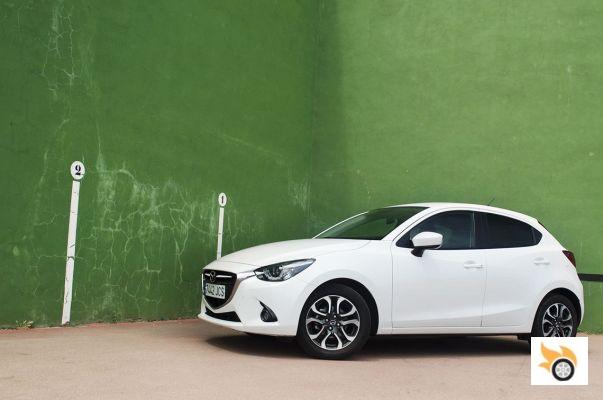
Aesthetically the family ties are getting closer and closer, being the front tremendously similar to the rest of the models in the range.
The previous Mazda2 was a car that I personally found attractive. But it had the downside of looking too much like its twin brother, the Fiesta. The new Mazda2 banishes that problem in one fell swoop. The front of the car gains the firm's new corporate grille, with an aggressive look with LED daytime running lights that play off the main projector, blending in with the chrome that frames the grille.
It's a car with a "bad-ass" look. The front overhang is not exaggeratedly long, and there is some distance from the front axle to the base of the A-pillar, which is visually pleasing, without sinning by excess, as it does with the five-door Mazda3. The nose is forward, while the windshield is more inclined and plays its cards well, with "little glass height" if you compare it with other rivals.
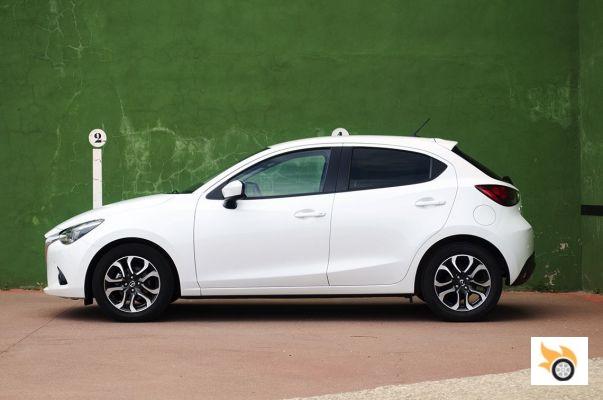
The side view reveals aluminium alloy wheels fitted with Toyo tyres (yes, Toyo as the first mount), with a generous profile. Although they are not low-profile tires shod on wheels of epic dimensions, the car is genuinely well, and serve to demonstrate that not always have to bet on mounting 18 wheels and low profile to every living car, which also has its dynamic advantage, as we shall see later.
The doors play with a line of ascending and curved style at the bottom, while the cabin has a C-pillar very sinewy and thin that is nice, even if it conditions the space in the rear seats.
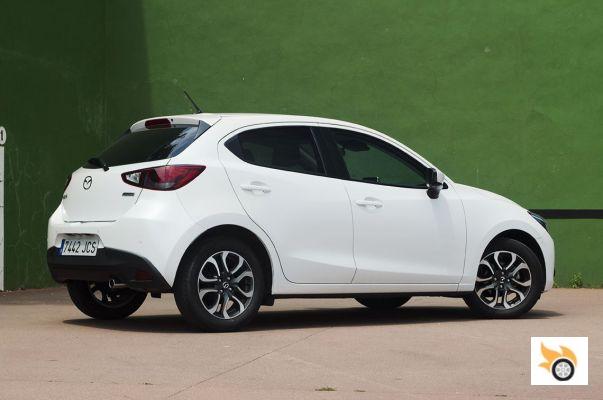
The rear is not "rapturous". It plays with triangular lights and a smooth and soft trunk lid, with the license plate moved to the bumper. The whole waistline of the body is accompanied by an organic styling line that plays with the profile and creates some extra light contrast to support the dynamism of a car that might otherwise be too bland.
All in all, it's not a car you'll be approached by admirers or admirers, but it's pleasing and above all balanced, without resorting to any great ordeals to the use of unnecessary ornamentation.
Cabin
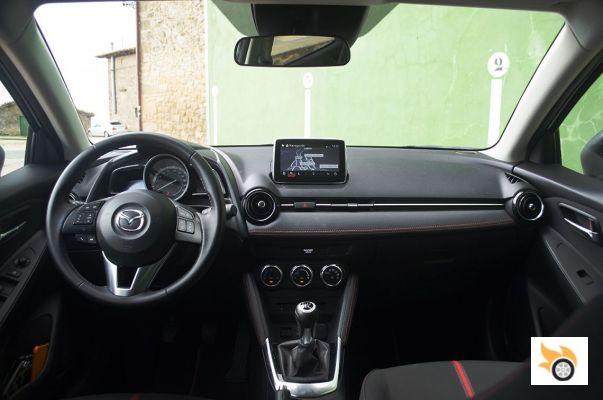
Finish, materials, fittings and size of front seats are a reference in the B-segment, even including "premium" models.
When you get into the front seats of the Mazda2, you're pleasantly surprised. The leap forward compared to its predecessor is huge, and not only that, but it becomes one of the references in its category, by design, materials and settings. For starters, the space in the front seats is one of the largest in its category, allowing you through the steering wheel and seat adjustments to easily find a good driving position. The pedal unit, with the accelerator tilting on the floor and a correct height of the brake pedal, even allows you to play toe-tap.
The multifunction steering wheel, besides having many buttons, is of high quality, as is the leather that covers it. The entire dashboard plays without soft plastics, but with quilted leather on its surface and embroidery in contrasting color to give it a touch of design. The asymmetrical air vents, the lack of excessive buttons and the large screen of the infotainment system put the finishing touches to complete a front seats whose only drawback is that the upper part of the backrest gives me the feeling of "going too fast backwards" and leave you.
The amount of soft leather surfaces where you rest your legs or elbows gives you that "well made car" feeling.
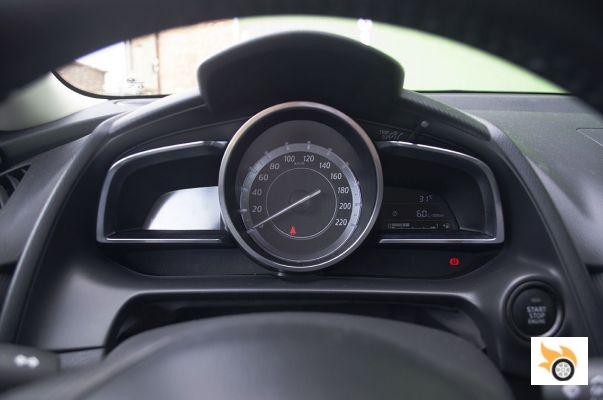
There are two possible dials for the Mazda2, the one with the digital rev counter makes checking the revs a hassle, the one with the central rev counter should be the standard one.
Mazda offers two possible clock displays on the 2. All trim levels except the Luxury have a central analogue speedometer, with a tiny digital rev counter on the left, and the fuel level and other information on the right. The Luxury version has what should be standard, in my opinion: central rev counter, digital speedometer nested inside it (as in the RX-8, yes), and the rest of the data on the attached displays.
There are several problems and several advantages with the clock box. In the first instance, I'll tell you that I think it's great to see a different layout than typical B-segment design. The version with the central rev counter and digital speedometer seems perfect to me, more so in petrol naturally aspirated cars like this one, where playing with the gearbox is a pleasure and a must. The problem of the version we tested, as already happened to the Mazda3 (which had the same box) is that the side digital display where the lap counter receives many reflections from the sun that sometimes make it impossible to read (just look at the picture above), besides being too small to consult it easily.
A coolant temperature clock is missing, on the other hand, replaced by a light that changes colour and disappears. It's blue when the engine is cold, disappears if it's at operating temperature, and lights up red if it gets too hot to film an "x-rated" movie.
As for the rest of the controls and information, the infotainment system's screen (standard on Style+ and Luxury trims) is tremendously intuitive. It's touch-sensitive, but it's best operated with the rotary knob between the seats. Without being BMW's iDrive or Audi's MMi, it's tremendously easy to manipulate and get to the options you want. The system is quick to react, the mapping of the browser is very successful, and the management of app's, pairing with the mobile phone and audio streaming are the best in the category.
The climate control system is single-zone (here there are rivals that have been offering two-zone systems for some time). It's a regular climate control system, but without digital screens. The good thing about it is that as it's a pure roulette system you can play with it without taking your eyes off the road.
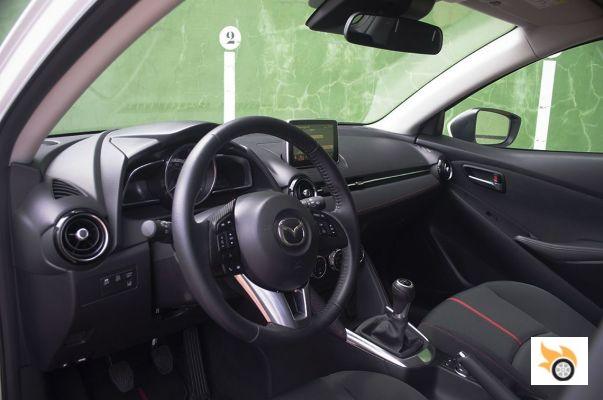
If you leave the front seats and go to the rear you will find another of the Mazda2's drawbacks. In width, at the rear, space has been lost compared to the outgoing model.
Three adults will be too tight, two will be better in width, but if they are relatively tall they will be too tight against the roof and in knee room. So, if you are going to buy the car to use the rear seats regularly and the occupants are going to be large people over 1.85, other models in the category (Polo, Fabia) are a better alternative.
If, however, the use of rear seats is for children, for people over 1.70 or for babies in strollers, the Mazda2 is more than adequate. As for the boot, the space (280 litres) doesn't shine as much as the Clio, for example (300), but its biggest drawback isn't the volume, as I don't think it's too small, but the height of the boot floor with respect to the load sill. This is very high, which favours the rigidity of the chassis, but also penalises the fact that you have to lift the luggage a lot to unload it.
Technology
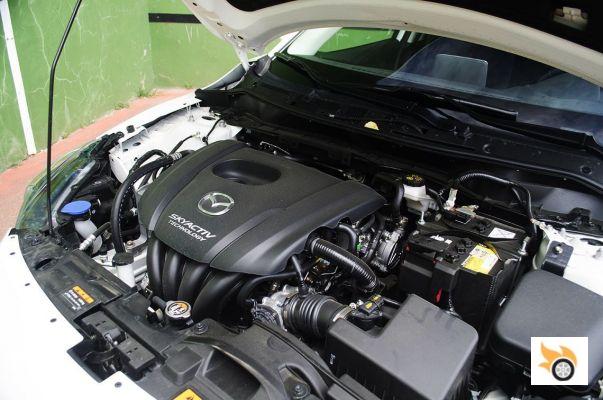
The Mazda2 could no longer take advantage of Ford's economies of scale, so it was necessary to create a platform specifically for a B-segment. The key to making it profitable was to use the chassis design base already employed in all previously launched models under the "SkyActiv" engineering principle, and so it was done. Starting from the monocoque of the Mazda CX-5 and Mazda3, the Japanese firm developed a shorter version, but with the peculiarity of a completely new rear suspension with semi-independent wheels joined by a torsional axle.
In some aspects (wiring, design of the crossmembers and longitudinal members) you could say that the car has something to do with the platform of its siblings, but to be honest, it changes so much that we can consider it a practically independent car, which will have to seek its fate sharing base with the CX-3.
The result is an exceptionally rigid chassis that also offers weight-saving advantages thanks to the extensive use of high and very high-strength steels. The front suspension is a McPherson strut, while the rear axle, as explained above, is a semi-independent system.
The engines are the real cherry on top of the car, in any case, especially the petrol engines. The Mazda2 pulls the same SkyActiv-G petrol block for its three variants, but in different power specs. It has a 1.5-litre displacement, direct petrol injection and a very high compression ratio (14:1) although it can run on 95 octane petrol.
Its power can be 75, 90 or 115 horsepower. There is a 105 hp diesel engine, SkyActiv-D, but as we'll explain below, there's no point in buying it, seeing how the petrol is doing, really.
The test car was the 90 hp with a five-speed manual gearbox (the 115 hp has a six-speed manual, like the diesel).
Technologically speaking, the car is served with a lot of equipment, standard or optional, which puts it on the list of the most complete cars in the segment. You can take from Head Up Display to headlights with LED technology for all functions (standard on Luxury). Other equipment highlights include lane departure warning, automated anti-collision braking and blind spot detection.
Driving
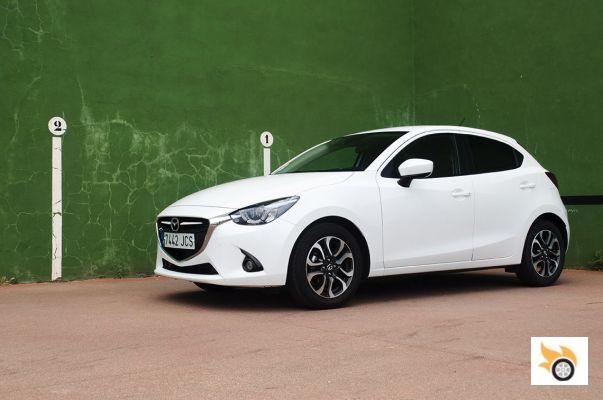
Finger to the starter button, and the 1.5 petrol starts instantly, with almost no time to let the starter motor make a noise. Surprisingly, at idle it vibrates a hair more than other cars in its class, and more than I remember in other Mazdas. That vibration disappears as soon as you give it a hair of gas and get going.
Starting from a standstill and shifting into first gear, I found the Mazda gearboxes to be the absolute reference in the market. The movement of the lever, the locking of them, the feel... everything is superlative. It's great. No effort, no free play. It's just perfect. If I worked for a manufacturer and that manufacturer wasn't Mazda, I'd buy one of these cars to see why I can't make gearboxes this good (that's for you, Fiat, Renault, Peugeot, Citroën...).
In the city the car already surprises you. The engine, although it is naturally aspirated, has a very good delivery, very progressive, from the bottom to the cut, with no hint of vibration, no matter how much you stretch it. It is comfortable at any engine speed, and has torque to move with ease. Although the maximum torque is at 4,000 revs, it is very comfortable playing from 1,700 revs and pulling the car in a linear way.
The engine is a delight in its smoothness and power delivery, although at idle it vibrates more than it should.
The throttle-torque coupling offered to the wheels is great. So much you accelerate, so much the car accelerates. We've become addicted to turbocharged engines over the last decade, with electronic throttles that put almost three-quarters of the torque on tap when you move your right ankle, and that's avoided at all costs with the Mazda2, which not only avoids those jerks and sudden changes in power delivery, but allows you to modulate the throttle with precision.
The steering is pleasant to drive on the street. The car turns effortlessly, and the generous ballooning of the tyres serves to absorb minor bumps, while speed bumps and speed humps are taken care of by the suspension, which doesn't "float or bounce" over them, but works without dryness. The springs are "just hard enough" and the dampers are open enough to allow the wheels to compress at the speed needed to swallow downed guards without your neck suffering.
The steering has a little too much assistance, especially in high-speed cornering.
At every stop, Mazda's Start&Stop system surprises. When they explained it to us years ago, they told us they wanted a system that would work in just a few tenths of a second, to make it imperceptible to the driver. To do this they had to stop the engine in a specific piston position and pull a super capacitor to provide the necessary power for an instant start. The curious thing is that they have succeeded, being by far the most successful Start&Stop system on the market.
More surprising if possible is to see the consumption of the car. Mazda promises an average of 5.9 litres per 100 kilometres in urban driving with this petrol engine. In the era of downsizing, we are always two and a bit litres short of the average fuel consumption (thanks to the fact that engines are made with the homologation cycle in mind, and this is not representative of reality). But Mazda hasn't made this engine thinking about low fuel consumption. Mazda has made it thinking about getting real low fuel consumption. Proof of this is that we averaged 6.1 in the city. Unheard of.
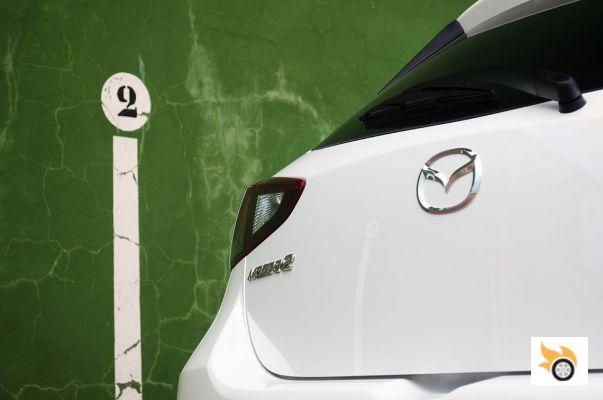
Leaving the city for a trip on the highway, motorway or national highway is useful to realize that the capabilities of the Mazda2 go beyond the city. The suspension works just as well in the city as it does in the city, as do the tires (Toyo, you surprise me, seriously). It's a car that doesn't tire as the miles go by. Its downside in this environment is that there's an excess of steering assistance, in my opinion, and although the car is a highway sharpshooter that doesn't break down trajectories even over bumps on the A1 at 120 mph, the reality is that it takes time to get used to the low weight of the steering wheel. Once you get the hang of it, you enjoy it much more.
Consumption in these circumstances is still surprising. Mazda reports a combined fuel consumption of 4.5 litres per 100 kilometres. We were left at 5.6 litres, 1.1 of the "official" average in what represents the smallest difference I remember between the declared and the verified in my history as a tester.
It's the first time we've been so close in our real consumption to the fuel consumption approved by the manufacturer in the city.
And if we go looking for the tickle? Here we are surprised again. I accelerate at full throttle looking for all the power of the engine, which reaches the cut without vibrating or complaining (it does it so smoothly that it's hard to notice, that's why I say I prefer the central rev counter, instead of the secondary side display so difficult to see). This 90-horsepower Mazda2 is no sprinter: 0-60 in 9.4 seconds, and a quicker 80-120 in 7.6 seconds, giving it a performance score of 19 points in our rating, which isn't bad, really. But the good thing is that it's eager to pull and offers a very flat torque curve, with a linear, smooth, progressive and bump-free response from low to cut-off. It's with these engines that you rediscover the pleasure of driving a naturally aspirated petrol and renounce the excessive obsession with over-boosting that pervades us today.
When I reach the first braking point, I find power and modularity in the central pedal. They are not the brakes of a Porsche, but they stop the car well. Downshifting is a delight, both for the set of pedals available and especially for the delicious feel of the gearbox.
In terms of chassis tuning, it is ahead of all its segment rivals, without a doubt.
To put the steering wheel in is to face again the slight excess of assistance, but once this is overcome, the car puts the nose in without nodding. It reaches the right stance with surprising clarity in a jiffy, keeping a large amount of free travel in the suspension, without leaning much at all. If you happen to hit a pothole in full support, it swallows it as if nothing happened. If you want to correct the trajectory, it cooperates. If you change from a right-hand corner to a left-hand one with braking in support in between, it doesn't complain either.
You come out of the corner, play with the gearbox again and you continue to fall in love. Even when you tighten the nuts, it's incapable of spending more than six and a half litres per hundred kilometres.
Don't be fooled, it's not a car for "traditional" fun. It's a car that lacks a lot of power to be a sport utility car, but its chassis is so good, and its engine is so fine, that you find, as it happened with the Mazda3, a car that goes great and even with only 90 hp and a "car for everything" approach you can enjoy the curves and get a good feeling.
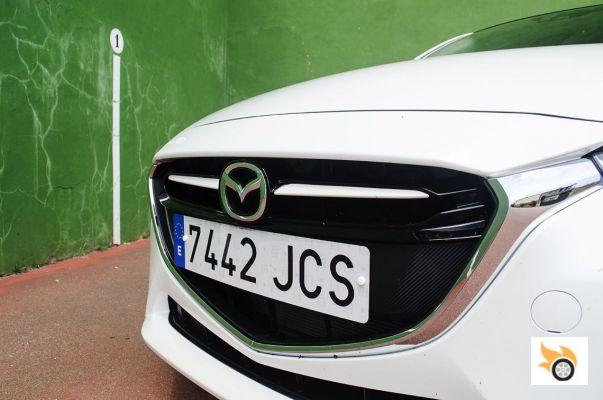
Coming back home from enjoying the curves and after passing through the supermarket, I couldn't help thinking about an MPS version that will never come, but that could take the real advantage of the chassis... The reality is that it is a car whose tuning, whose basic ingredients, are difficult to improve, being the reference in these aspects in its category, without a doubt.
With every kilometre you drive with it you notice how the suspension has the perfect geometries. How choosing tyres with a "decent" profile benefits its absorption capacity. How the weight savings and its distribution around the centre of gravity make the car want to go in and out of corners, and not fight against you.
Conclusions
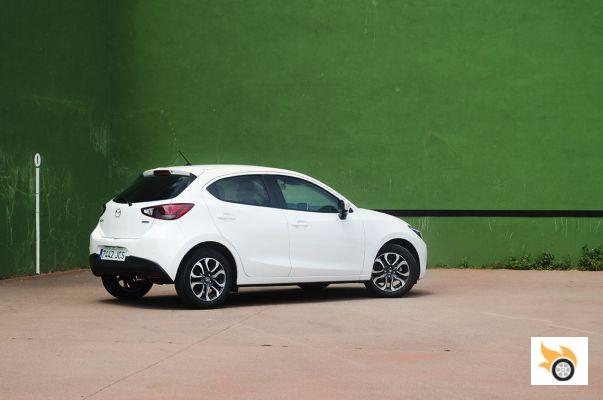
This Mazda2 is unique for that reason. Dynamically, it's well above what you'd expect or demand from a 90 horsepower hatchback. It gives that feeling of being "ultra-sober" chassis for the size of engine used. But let's get to what matters, which is to draw valid conclusions for a potential customer of a utility of this profile.
The good things about the Mazda are clear: it has a delicious engine, that uses very little fuel, that doesn't vibrate when driving, that makes little noise and that is easy to drive from the right pedal. The gearbox is great. It can be very well equipped... It's better on equal power, in terms of handling and handling than any of its segment rivals.
Where does it falter? If you're fussy about prices, the Skoda Fabia with the 90bhp engine starts at £13,340 in its basic trim level, while the Mazda will set you back £14,240, although it has the advantage of being slightly better equipped. A 90 horsepower Polo goes to 16.145€, clearly more expensive, while a five-door Ibiza (the best selling of the category in our country) is at 15.930€, being also more expensive than the car from Hiroshima. So in that sense, it can't be said that the Mazda2 is more expensive than its rivals with the 90 hp engine.
If you're considering buying a B-segment car, the Mazda2 should be among your favourites, unless you're going to be using the rear seats intensively with people taller than 6'2".
The other "weak" aspect is the space in the rear seats, as we have told you, or the difference in height of the trunk floor, but this, if you are considering buying it, you should relativize it with a visit to the dealer and assess it in its right measure according to your personal needs.
If you ask me for a buying advice, I will tell you that, seeing how the petrol engine goes, and how much fuel it uses, the diesel doesn't make any sense, so I would rule it out from the start. In terms of power, the 90 hp is enough for overtaking and getting around, but the chassis is so good that I'd go for the 116 hp. Equipment level? If only for the central clock with the lap counter and LED headlights, I'd go for the Luxury, which brings us to the 16,090€, which is not little for a utility car, of course.
In any case, if you're thinking about buying a B-segment car, the Mazda2 should be among the top candidates, especially if you're into the art of driving.

























